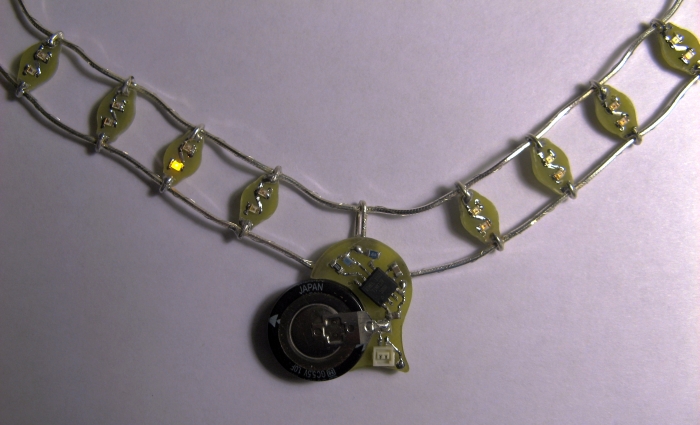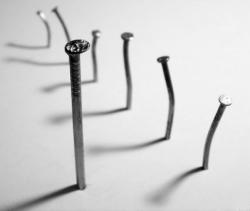Feed SparkFun Electronics [copy] http://www.sparkfun.com/feeds/news has loading error: cURL error 22: The requested URL returned error: 405
Feed The RFID Weblog [copy] http://www.rfid-weblog.com/index.rss has loading error: cURL error 22: The requested URL returned error: 404 Not Found
Feed tqfp.org [copy] http://tqfp.org/rss/ has loading error: A feed could not be found at `http://tqfp.org/rss/`; the status code is `200` and content-type is `text/html; charset=utf-8`
Электронное ожерелье. Часть 1

Идея делать украшения из электронных компонентов не нова. Особенно приятно, если это не просто красивая кучка деталек, а работающая схема, которая светится, мигает и переливается… Расскажу о своем опыте конструирования подарка на 8 марта.
Будет много картинок
Две стороны повсеместного применения микроконтроллеров

Микроконтроллеры (старое красивое название — однокристалльные микро-ЭВМ) в настоящее время имеют невероятно много областей применения. От промышленной автоматики до бытовых приборов, от управления ядерными станциями до детских игрушек, от секретных военных систем до переключения каналов в вашем радиоприемнике. Одним словом, проще перечислить, где они не применяются.
Изобретение и дальнейшее развитие микроконтроллеров произвело настоящую революцию в цифровой электронике. Изменились не только схемотехника и элементная база, но и сами принципы построения систем. Значительные изменения претерпел цикл разработки. Появились целые классы устройств, существование которых было бы невозможно без контроллеров.
Но у всякой технологии, как бы хороша она не была, всегда есть обратная сторона. Сюда относятся...
Тролльская схемотехника. Решение
https://invidious.privacyredirect.com/watch?v=RkTvDjhImwo
Несколько месяцев назад много шума наделала задача от пользователя Youtube Fredzislaw100 про три светодиода с выключателями (пост на Хабре). Напомню: на видео показано, как из обычных, на первый взгляд, деталей — батарейки, резистора, трех светодиодов и трех выключателей — собирают последовательную цепь, в которой каждый выключатель управляет своим светодиодом.
В чем же секрет фокуса? Недавно автор опубликовал разгадку.
Читать дальше →
Однопиксельную контактную линзу проверили на человеке

Не так давно была новость о создании контактной линзы со встроенным светодиодным дисплеем, пока разрешением в 1 пиксель. Прототип испытывали на кроликах. Американец Бен Краснов (Ben Krasnow) не стал дожидаться, пока начнутся испытания на людях, и собрал собственную линзу со светодиодом. И не просто собрал, а испытал на себе. Честно говоря, результат выглядит жутковато: нечто, сделанное «на коленке», из проволоки и скотча — и живому человеку в глаз. Одним словом, настоящий киберпанк!
Подробнее о страданиях во имя науки...
[Перевод] Взлом защиты от копирования HDCP с помощью MitM-атаки

HDCP (англ. High-bandwidth Digital Content Protection — защита цифрового содержимого с высокой пропускной способностью) — технология защиты медиаконтента, разработанная корпорацией Intel и предназначенная для предотвращения незаконного копирования высококачественного видеосигнала, передаваемого через интерфейсы DVI, DisplayPort, HDMI, GVIF или UDI. Защищённый видеосигнал может быть воспроизведён только на оборудовании, поддерживающем HDCP.
Википедия.
Уже более десяти лет широко используется защита от копирования HDCP, разработанная фирмой Intel. Этой защите доверяют медиа-корпорации, ведущие бизнес в сфере цифрового видео и аудио высокого разрешения, с оборотом в миллиарды долларов. Исследователи из рабочей группы по информационной безопасности аппаратного обеспечения во главе с профессором по имени Tim Güneysu из Рурского университета (Ruhr-Universität...
Android Hardware Development Environment

My favorite part of the Android Hardware Development Environment is that I can easily connect to a serial port/ use the USB host capabilities with Android. When I'm done with my project I typically burn my custom image of Android to a microSD card so I can reuse my operating system!
Картина и гвозди

Имеется картина, к которой двумя концами привязана длинная веревка. Требуется повесить её на N вбитых в стену гвоздей так, чтобы при вытаскивании из стены одного любого гвоздя картина и веревка падали.
Веревка имеет пренебрежимо малую толщину, не рвётся и нерастяжима, гвозди не гнутся и перпендикулярны стене, трения нет. Одним словом, задача решается без всяких хитростей и уловок.
Читать дальше →
[Перевод] «Камера» из светодиодов

В этой заметке речь пойдет о том, как массив светодиодов может быть использован в качестве «камеры» очень низкого разрешения (20 пикселей). Практического смысла в этом немного, но опыт применения светодиодов в качестве фотодатчиков может оказаться для кого-то полезным. В работе используется плата Arduino Blinkenlight Shield, изначально предназначенная для демонстрации световых эффектов.
Читать дальше →
Неравномерно идущие часы

Идея этих часов состоит в том, что стрелки на них двигаются неравномерно, то ускоряясь, то отставая, но тем не менее, в среднем, часы показывают правильное время. Сейчас расскажу, как такие сделать.
Читать дальше →
[Перевод] Перехват нажатий клавиш смартфона при помощи акселерометра

Двое исследователей из Калифорнийского университета в Дэвисе (UC Davis), Хао Чэнь (Hao Chen) и Лянь Цай (Lian Cai) нашли способ определять, какие клавиши были нажаты на экранной клавиатуре ОС Android путем измерения смещений, покачиваний и вибрации устройства, измеренных встроенным акселерометром [Прим. перев.: и гироскопом]. Это важно, поскольку данные от акселерометров не рассматривались как потенциальный вектор атаки, и, таким образом, свободно доступны любому приложению на любом смартфоне или планшете.
Читать дальше →